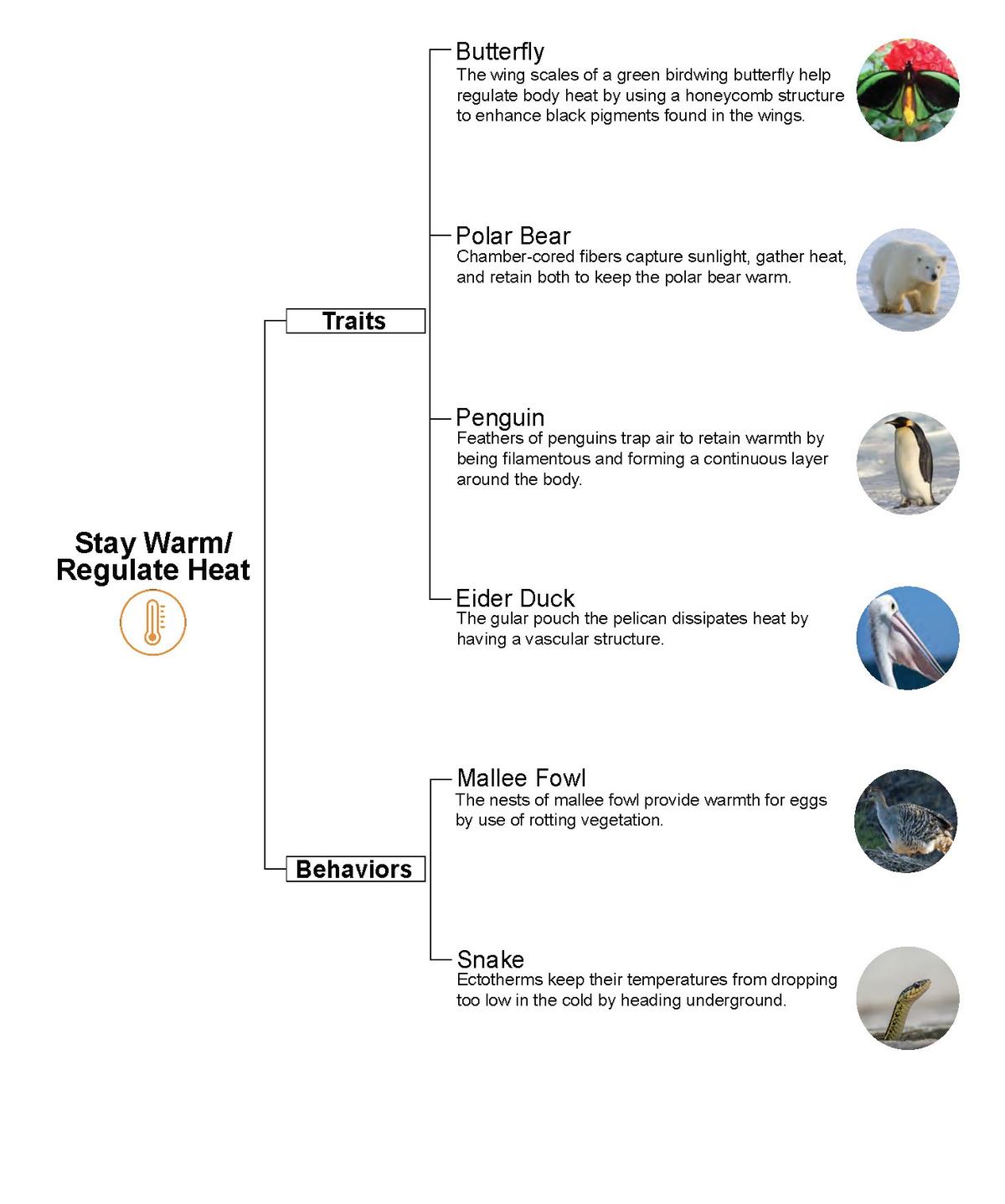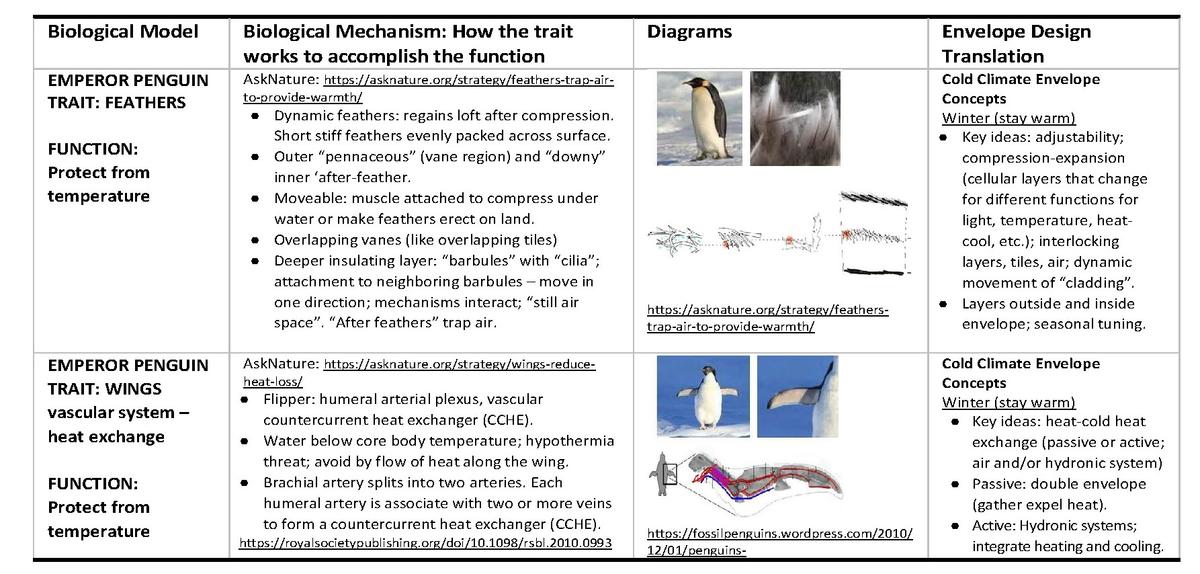We haven't succeeded in mimicking nature's grace, efficiency-and most importantly-sustainability. We're coloring outside the lines and making a mess. Let's look again, using nature as our model..." - Jay Harman
What does it mean to "Select and Abstract Strategies"?
After generating a list of possible biological systems to consider with respect to the design challenge, the next step is to move from the list of design criteria and identified biological models to the ones that are most appropriate for more detailed study and application (Figure 7). The first step is to consider whether any are a better match to the challenge. This may be a question of scale, materials, or the fit of the analogy. For instance, physical properties often play out differently at nano scales versus macro scales and moving from one scale to another is not possible – in which case a different biological system that matches the scale of the application (e.g., nano to nano or macro to macro). In other cases, the physical properties of the materials need to match, for instance, when filtering air in an application, some aspects of water filtration may apply, but looking at air filtration may be more relevant to the design inquiry.

How do you "Select and Abstractize Strategize?
The next step is to consider the range of functions that apply to a biological system and determine how these may relate to tradeoffs associated with the traits that support the functions. Most biological traits do more than one thing for the organism. A butterfly wing may absorb light and heat to rapidly waft pheromones to attract a mate, but it also repels water and permits flying. In some cases, evolutionary selection in one context may constrain how selection in another context operates and the trait may not be “optimized” for the function a designer is most interested in. For instance, the heat-absorbing function of the butterfly wing would presumably be of more interest to the designer than would the dispersion of pheromones (Snell-Rood and Smirnoff 2023, in review).
Once the biological systems being studied for inspiration have been narrowed, the next step is to delve deeper into the biological literature. In many of the biological sciences, researchers work to generate a mechanistic model, or working hypothesis, that relates “trait form to function”.
In other words – can we draw a diagram of how the trait works (Table 1)? In many cases, we understand how a biological trait works, and it's just a matter of finding it in the literature. For instance, the basic model for a bird beak crushing a seed is a lever system imposed on a bird skull. Other adaptations in terms of internal beak structure or skull shape are often layered on top of this basic understanding. Here, the designer might draw a diagram of a lever system that is moderated by other adaptations in the system and use this as the abstraction for the biological strategy. In some cases, it may be obvious that a trait is related to some function of interest, but as we learn more, we realize that it is not completely understood just how that trait works. In this case, the abstraction of the biological strategy may currently be a “best guess” or simply in need of more study, in which case the designer may opt to move on to a new system, or perhaps partner with a biologist to study the trait in more detail.
In the envelope example, Figures 7 and 8 illustrate the process of moving from “many to one” for the biological model. The biological traits and mechanisms used to stay warm were studied for six species and eventually narrowed to one species (the emperor penguin). The biologists selected the top six models and recommended the emperor penguin because the problem (dealing with cold) and the scale (macro versus nano) match the design challenge. In addition, multiple adaptations in the penguin to an extremely cold climate are well understood and studied sufficiently to provide the detail necessary to abstract biological traits of the penguin into design strategies.
The biological mechanisms and traits that provided warmth were further researched. In addition to function and biodiversity, evolution was considered in how the biological traits respond to varying environmental and behavioral conditions. A detailed investigation of the feathers and wings of the emperor penguin was developed and translated into conceptual design ideas. Table 1 provides an example of the process used to clarify the functions, traits, and mechanisms used by the emperor penguin’s feathers and wings to stay warm. Based on these strategies, envelope design concepts were developed. The steps below describe the process used to curate and abstract the biological strategies for design.
Step 4 Example: Curate and Abstract the Biological Strategies to Inform Design
- Evaluate the strategies of select biological models based on design criteria and function, biodiversity, and evolution: Evaluate the biological models from Step 4 based on the identified design challenge and problem (staying warm). Identify the biological traits and mechanisms to achieve the function (staying warm). Consider functions across different species in the tree of life (evolutionary time) and different biomes (evolutionary space).
- Select and organize biological models for design: Select the most relevant biological models from Step 4 and translate into the design process (example Table 1). Consider different biological lenses (form, process, system, and materials). Use diagrams, sketches, narrative texts, or other means to identify and organize the biological strategies to inform and translate into conceptual design scenarios in the next step (Figure 9).

References
Snell-Rood, EC and Smirnoff, D. 2023 in review. Biology for Biomimetics I: function as an interdisciplinary bridge in bio-inspired design. Bioinspiration and Biomimetics.